Dan Birchall is at it again, using his vantage point at Subaru to shoot time lapse of Keck and some other telescope using lasers over the summit of Mauna Kea…
Category: Astronomy
Exploring the cosmos
Shaken and Back On-Sky
I understand it was quite the scramble, but both telescopes are back on-sky tonight.
The earthquakes started just after two this afternoon with the magnitude 4.5 event that got our attention so quickly. This gave day crew three hours to have everything inspected, checked out and ready for the night. Physical inspections, instrument checkouts, and more, an extensive checklist to follow and insure that no real damage was done by the temblors. Just after 5pm we got word that everything was good-to-go and both telescopes would be released for the night’s observing.
As of writing this, about ten hours after the first quake, there have been 32 separate events under Mauna Kea detected by the seismographs. A half dozen of those were near magnitude three. I have felt thirteen separate aftershocks, this plus the original quake makes fourteen, the most I have ever felt in a single day by a wide margin.
The USGS has released a statement noting that this was probably a “structural adjustment” a result of the enormous weight of Mauna Kea stressing the underlying rock…
Magnitude 4.5 earthquake on the north flank of Mauna Kea
By USGS/HVO
Hawai‘i Island, HAWAII—The U.S. Geological Survey’s Hawaiian Volcano Observatory (HVO) recorded a magnitude-4.5 earthquake located beneath the Island of Hawai‘i on Wednesday, October 19, at 2:10 p.m. HST. This earthquake was centered about 9 km (6 mi) northwest of Mauna Kea’s summit and 49 km (31 mi) west-northwest of Hilo, at a depth of 18.7 km (11.6 mi).
The earthquake was widely felt on the Island of Hawai’i. The USGS “Did you feel it?” Web site (http://earthquake.usgs.gov/eqcenter/dyfi/) received more than 500 felt reports within an hour of the earthquake.
The earthquake was the largest in a cluster of about 20 earthquakes on the north flank of Mauna Kea on Wednesday afternoon. Most of these aftershocks were too small to be felt, but, as of 3:30 p.m., two earthquakes with magnitudes greater than 3.0 had occurred in addition to the magnitude-4.5 event.
Over the past 25 years, the north flank of Mauna Kea has experienced 10 earthquakes greater than magnitude 4.0, including today’s event, at depths of 10–40 km (6–25 mi). Deep earthquakes in this region are most likely caused by structural adjustments within the Earth’s crust due to the heavy load of Mauna Kea.
Adjustments beneath Mauna Kea during past similar events, such as in March 2010, have produced a flurry of earthquakes, with many small aftershocks occurring for days after the main quake. Given this history, it is possible that additional small earthquakes may be recorded in the coming days.
Today’s earthquakes caused no detectable changes on the continuing eruption of Kilauea Volcano.
For eruption updates and information on recent earthquakes in Hawai’i, visit the Hawaiian Volcano Observatory website at http://hvo.wr.usgs.gov
More Shaking
This is starting to look ominous! Nineteen events so far and counting, it seems the building rattles every 10-20min with another aftershock. Will it please settle down?
Word is that Keck1 is fine, we are scheduled to do some engineering with the AO laser. The laser itself is still on and operational, a minor miracle. There may be some issues with Keck 2 after the initial quake. We are waiting for a more detailed report from the summit crew.
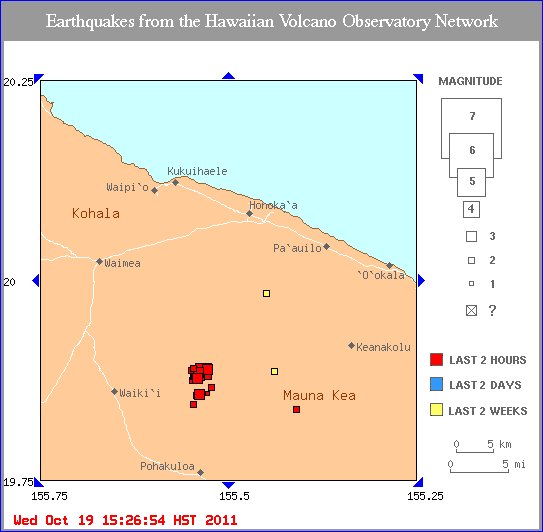
Titan before Rings
A world shrouded in hydrocarbon smog, where there are rivers and lakes collecting methane rain. Despite numerous flybys of the Cassini spacecraft and landing of Huygens probe on the surface, Titan remains a very mysterious world. A thick atmosphere and exotic chemistries create conditions that might even harbor some form of life.
Taken from this angle, the view looks toward the side of Titan that always faces away from Saturn. Keep in mind that Titan is 5,150 kilometers (3,200 miles across), much smaller than the Earth, but quite a bit larger than our Moon. The image was taken with the Cassini spacecraft narrow-angle camera on Aug. 9, 2011 using a spectral filter sensitive to wavelengths of near-infrared light centered at 938 nanometers. The view was acquired at a distance of approximately 1.4 million kilometers (870,000 miles) from Titan and at a Sun-Titan-spacecraft, or phase, angle of 35 degrees. Image scale is 8 kilometers (5 miles) per pixel.
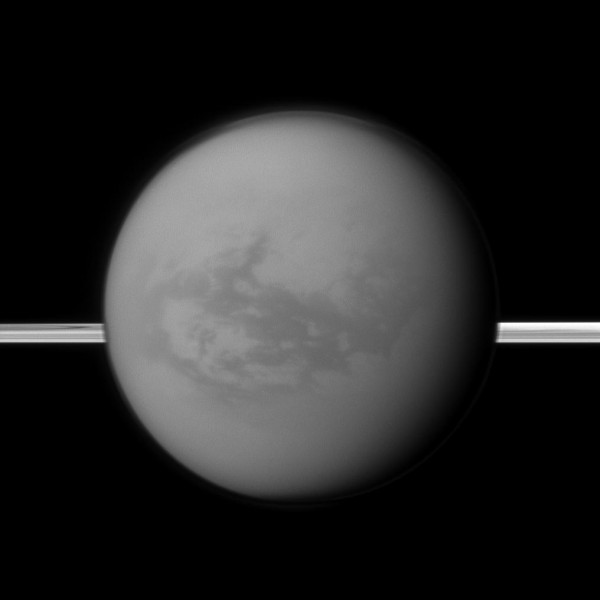
Postcard from the Summit – Sunset Panorama
Comet iPhone App
One drawback to the many iPhone astronomy apps is the lack of large databases. To an advanced amateur such as myself, the lack of detailed databases is a distinct negative in these programs. I venture way beyond the Messier catalog, or even the NGC on a regular basis. I understand the price to be paid in speed and memory required to support larger databases, but I would like to have the option.
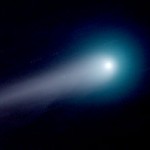
There is one decent answer for comets… I found a very nice app for comet ephemerides published by Keith Yohn. Called simply Comet, this free program downloads the latest ephemeris data from the Minor Planet Center and displays the current and future coordinates for each comet. Just what I needed!
There are no charts, the data is simply displayed in table form. Every observable comet is displayed and can be search for using a simple set of filters.
When attempting to observe comet C/2009 P1 Gerradd a few times recently. I have found the coordinates to be quite accurate. The comet was in the sky, right where the app showed it would be. Nothing like a real world test.
Nobel Prize in Physics Awarded for Accelerating Expansion of the Universe
The expansion of the universe is accelerating, and this is likely driven by dark energy, a mysterious repulsive force. Three astronomers won the Nobel prize on Tuesday for their research on exploding stars, or supernovae, that led to this profound cosmological conclusion. They are Saul Perlmutter of the Lawrence Berkeley National Laboratory in Berkeley, California, Brian P. Schmidt of the Australian National University in Weston Creek, Australia, and Adam G. Riess of the Space Telescope Science Institute and Johns Hopkins University in Baltimore, Maryland. Their discovery relied fundamentally on spectroscopy using the W. M. Keck Observatory and its LRIS spectrograph, in the period 1995 to 1997.
Perlmutter, Schmidt and Riess were members of two competing teams who were both studying the most distant supernovae. These Type Ia supernovae have been demonstrated to be “standard candles” and can thus yield relatively precise cosmological distances. The Keck spectra of the extremely distant supernova candidates were essential in order to indicate they are Type Ia, and to determine the redshift, or its velocity as seen from Earth, of the galaxy hosting the supernova. It was the redshifts and distances of a modest number of distant supernovae that revealed that the expansion of the universe was not slowing down, as was predicted, but in fact was inexplicably speeding up. The accelerating expansion of the Universe, first reported in 1998, was confirmed by the two separate groups. This accelerating cosmological expansion and the hypothesis that it is driven by dark energy has now become one of the most important areas of study in astronomy and physics today.
At the time, “We were a little scared,” Schmidt said. Subsequent cosmological measurements have confirmed that roughly 70 percent of the universe by mass or energy consists of this anti-gravitational force called dark energy.
In fact, Albert Einstein introduced this bizarre behavior with a fudge factor in his equations in 1917 to stabilize the universe against collapse. He later abandoned this idea, and then considered it his greatest blunder. “Every test we have made has come out perfectly in line with Einstein’s original cosmological constant in 1917,” Schmidt said.
In the years since then the three astronomers, along with their collaborators, have shared a number of awards, including the Shaw Prize in Astronomy, for this ground breaking research.
Perlmutter, who led the Supernova Cosmology Project out of Berkeley, will get half of the prize of 10 million Swedish kronor ($1.4 million). The other half will be shared between Dr. Schmidt, leader of the rival High-Z Supernova Search Team, and Riess, who was the lead author of the 1998 paper in The Astronomical Journal, in which the dark energy result was first published. They will receive their prizes in Stockholm on December 10.
“The recognition by the Nobel Committee of the importance of this work validates the enormous value to our society of ground-based optical / infrared astronomy,” said Taft Armandroff, Director of the W. M. Keck Observatory. “By making our two Keck telescopes and their instruments work at the highest performance, transformational science like that of Saul Perlmutter, Brian Schmidt and Adam Riess happens.”
The W. M. Keck Observatory operates two 10-meter optical/infrared telescopes on the summit of Mauna Kea on the Big Island of Hawaii. The twin telescopes feature a suite of advanced instruments including imagers, multi-object spectrographs, high-resolution spectrographs, integral-field spectroscopy and a world-leading laser guide star adaptive optics system. The Observatory is a private 501(c) 3 non-profit organization and a scientific partnership of the California Institute of Technology, the University of California and NASA.
Supernova 2011fe in M101
I have been watching the supernova nearly since it erupted around 23 Aug. We first viewed the supernova on 26 Aug using Cliff’s 24″ scope in the schoolyard of Waikoloa Elementary. I have since seen it about half a dozen times, as it brightened and peaked at around 10th magnitude in mid September. The supernova has since dimmed somewhat, now about 11.5 magnitude, but still quite easy to find with a small telescope. It is brighter than the host galaxy, M101.
Not a great picture. The galaxy was setting and I was shooting as it slid behind the shoulder of the mountain. All I could manage was a quick sequence of a dozen 30sec images. Still, you can actually see the galaxy and supernova. The image is much as it appears in a larger telescope around 14-20″ of aperture under a dark sky.

Postcard from the Universe – Jupiter and Moons
A nice image of Jupiter with the moons (left to right) Europa, Ganymede and Io. Taken early Sunday morning from Hale Pohaku. Conditions were quite nice, both for photography and simply observing by eyeball through the telescopes set up.
The telescope used is not mine, but belongs to fellow club member, Maureen. We had just collimated the ‘scope, aligning the optics for optimum performance. I wondered just how good the performance might be. The answer? Pretty good!
I used the Canon 60D to shoot the video. The ‘scope was a Celestron 9.25″SCT operating at f/10. The camera has a 640×420 cropped video mode that is ideal for this sort of use. Shooting at 60fps it generates very high quality video.
The frame is a stack of 900 frames selected from well over 1500 frames in the source video. The result is quite pleasing, particularly the moons. Three of the four large Jovian moons are visible. They appear as disks, with the larger Ganymede notably bigger than the smaller Io. The disk of Jupiter shows good color and cloud formations. Overall the result is excellent and shows the promise of using the DSLR to shoot planetary video. I will be experimenting with this method and expect even better results in the future.
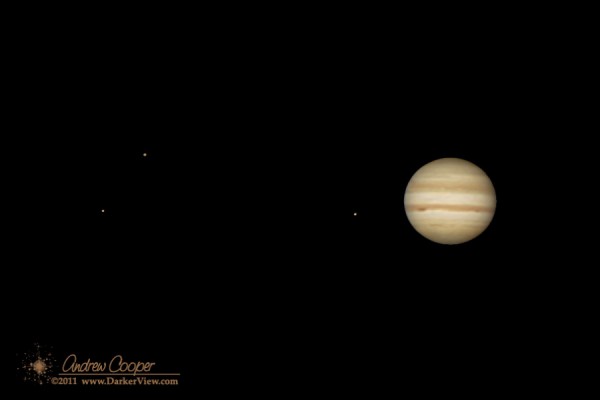
Shooting in the Dark
A supernova, a comet, a new camera and a dark night.
I have had the Canon 60D for a while now. Since April in fact. It was my main carry camera in Alaska this summer. This was the camera used to produce the laser shots and videos that were published far and wide. But I have never used the camera on a telescope. A new Moon observing weekend is an opportunity to change that.
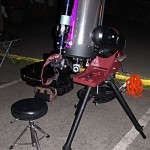
While my camera was busy shooting sequences, I wandered around and visited with the other folks enjoying the night. A few peeks through other scopes at favorite objects was about all the visual observing I did. There were a couple groups using cameras without telescopes to shoot stars capes under the dark sky. We traded hints as multiple cameras worked the night.
An orange glow in the clouds betrayed new lava flows on Kilauea. Even thirty miles away we could make out bits of a channelized a’a flow. The pair of binoculars I had brought became one of the most popular optical instruments around.
I was using the rig without any autoguiding, as a result guiding errors spoiled a number of exposures. I kept the exposures short, and shot bright objects. I have sequences to process of a lot of old favorites… M31, M42, a few open clusters like M11 and M38, the Pleiades and more. Just before dawn I even shot a sequence of the Tarantula Nebula skimming the slope of Mauna Loa. Two 8Gb SD cards filled and part of a third. I will be some time processing the many images taken through the night. There is even some video of Jupiter and Mars to process into high resolution planetary images.
There were three telescopes still operating when dawn appeared. Maureen, Cliff and myself watched as the sky grew bright and a thin crescent Moon rose above the slopes. Even then we spent a little time observing and photographing the Moon or Mars as the stars disappeared. We were still breaking down gear as sunlight swept the hillsides around us. Tired and yet elated we greeted the Sun.

